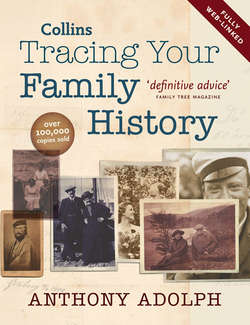Читать книгу Collins Tracing Your Family History - Ryan Tubridy, Anthony Adolph - Страница 80
DEATHS
ОглавлениеThe indexes give:
The deceased’s name
The district in which they died
A reference number
Age. For the early decades they do not include ages, so a reference to someone who you thought was your 90-year-old great-great-grandfather might turn out to have been a day-old baby. Between June 1866 and March 1969, they include the deceased’s age, and after then the date of birth is given.
Most people tended to marry around their twenties, so it is often easy to guess very roughly when people’s marriage and births might have taken place. The same is not true of deaths and this, coupled with the sparse information given in the indexes before 1866, tend to make death searches difficult. Here are some pointers:
A marriage certificate will often state whether the bride and groom’s fathers were alive at the time.
You can get an idea of when someone might have died by their appearance or non-appearance in some of the fully indexed census returns (see Chapter Six).
Elderly relatives can give you an idea of when someone might have died simply by virtue of whether they can remember them or not, so if 87-year-old great-aunty can remember someone, you know that person must have died less than 87 years ago.
Because death indexes are so uninformative, it can sometimes be easier to look for the person in the indexes to wills first (see here). This will give you a date of death, and you can then buy the death certificate to learn their age.
